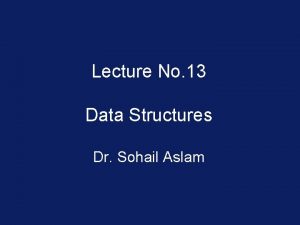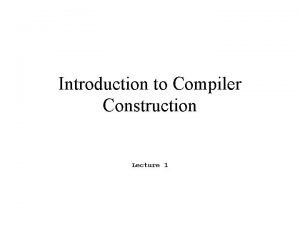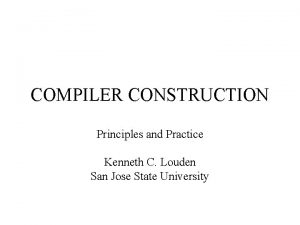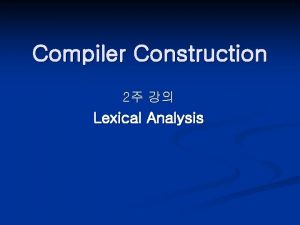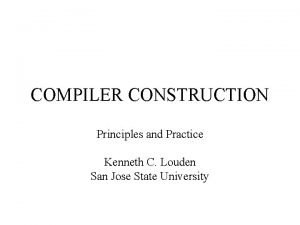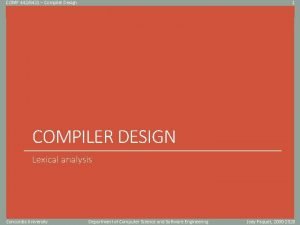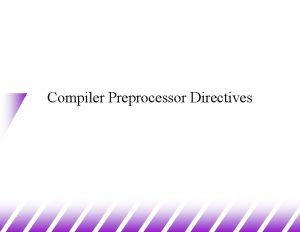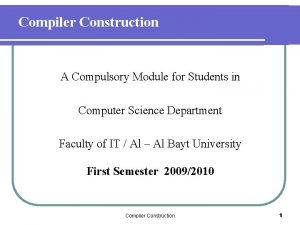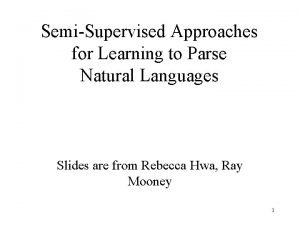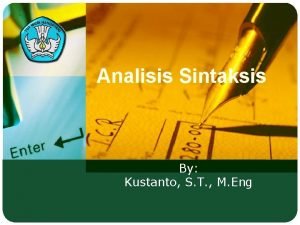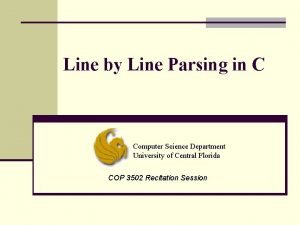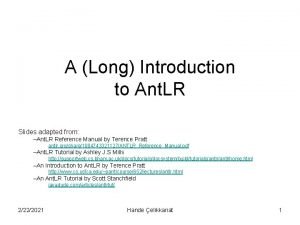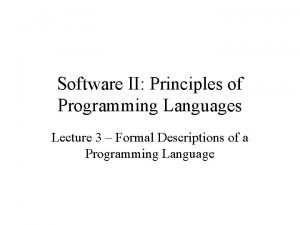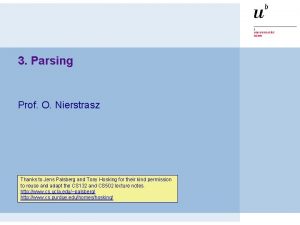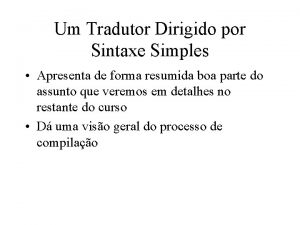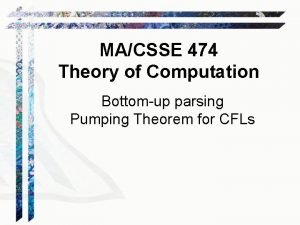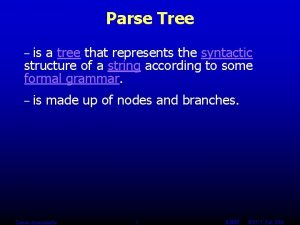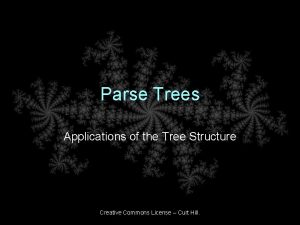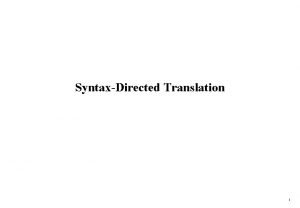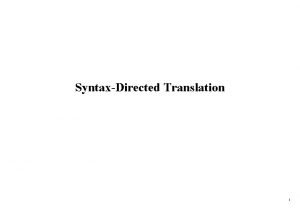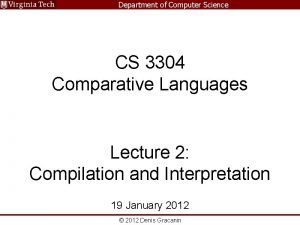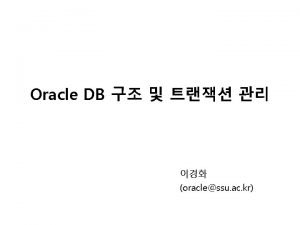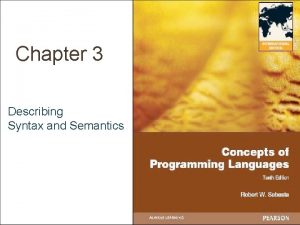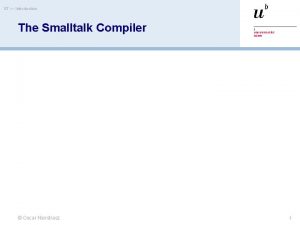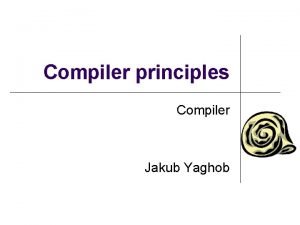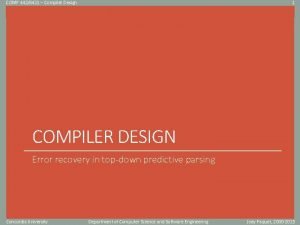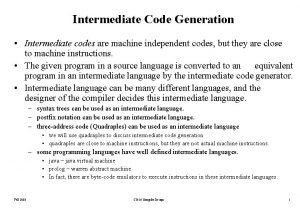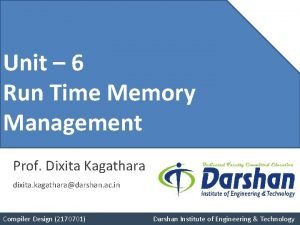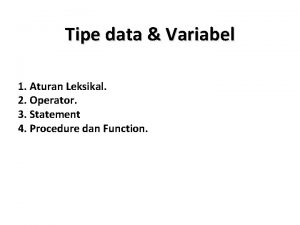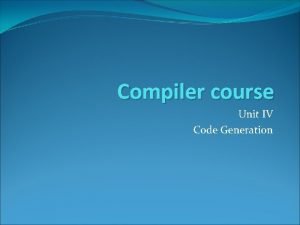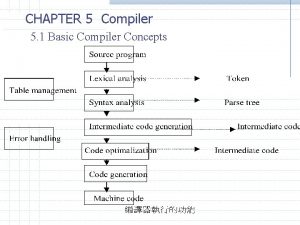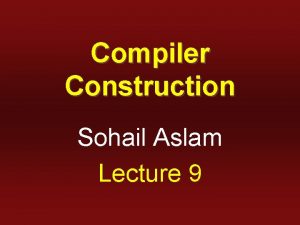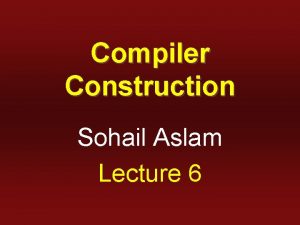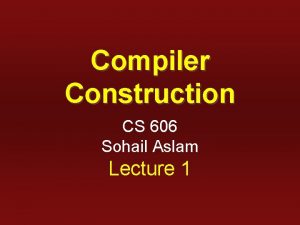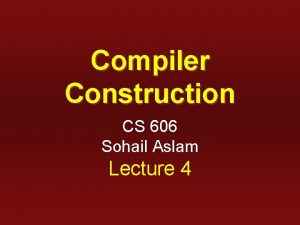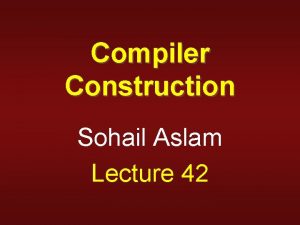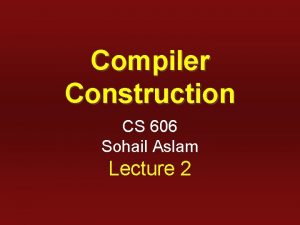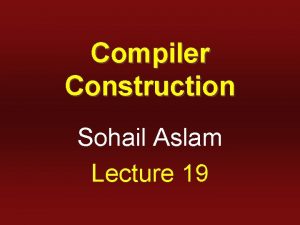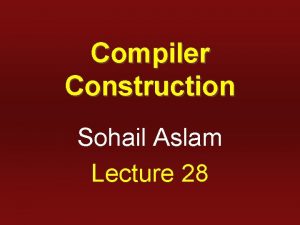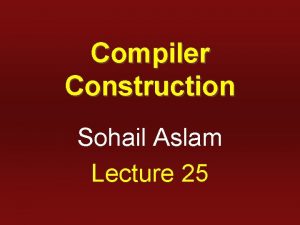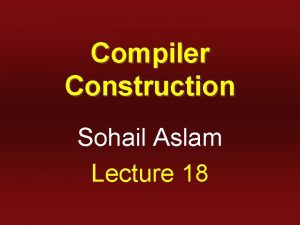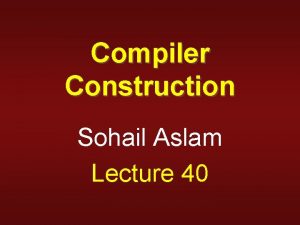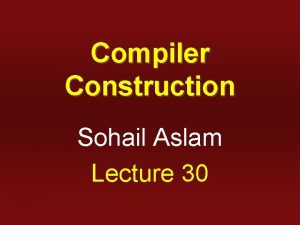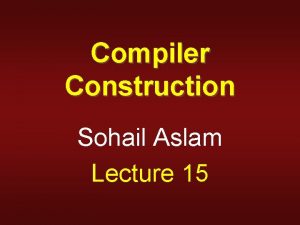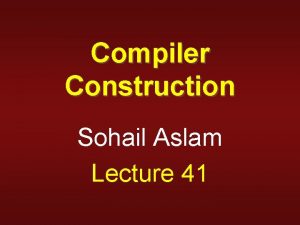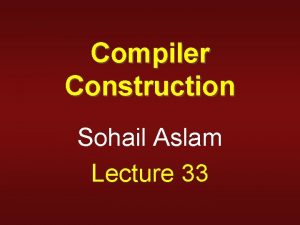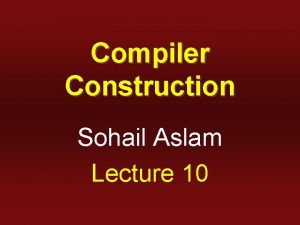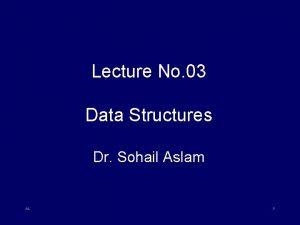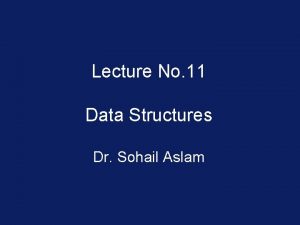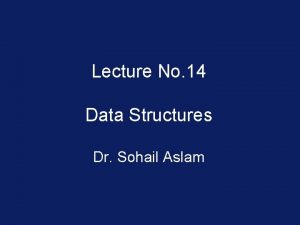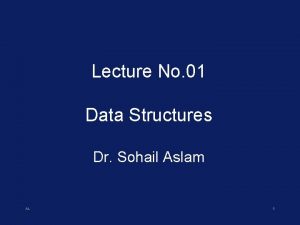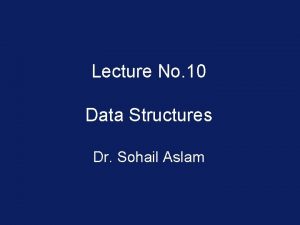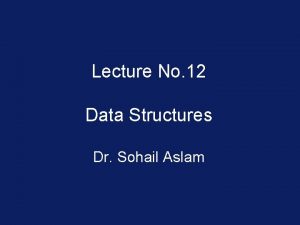Compiler Construction Sohail Aslam Lecture 12 Parse Trees






















































- Slides: 54

Compiler Construction Sohail Aslam Lecture 12

Parse Trees Leftmost derivation G E E op x – E E op E 2 * y 2

Parse Trees G E E op x – evaluation order x–(2*y) E E op E 2 * y 3

Parse Trees G E E E x op – E 2 Rightmost derivation op E * y evaluation order (x – 2 ) * y 4

Precedence § These two derivations point out a problem with the grammar § It has no notion of precedence, or implied order of evaluation 5

Precedence § These two derivations point out a problem with the grammar § It has no notion of precedence, or implied order of evaluation 6

Precedence To add precedence § Create a non-terminal for each level of precedence § Isolate corresponding part of grammar 7

Precedence To add precedence § Create a non-terminal for each level of precedence § Isolate corresponding part of grammar 8

Precedence To add precedence § Create a non-terminal for each level of precedence § Isolate corresponding part of grammar 9

Precedence To add precedence § Force parser to recognize high precedence subexpressions first. 10

Precedence For algebraic expressions § Multiplication and division, first. (level one) § Subtraction and addition, next (level two) 11

Precedence For algebraic expressions § Multiplication and division, first. (level one) § Subtraction and addition, next (level two) 12

Precedence For algebraic expressions § Multiplication and division, first. (level one) § Subtraction and addition, next (level two) 13

1 2 3 4 5 6 7 8 9 Goal expr term factor → → | | → | expr + term expr – term factor term / factor number Id 14

level two level one 1 2 3 4 5 6 7 8 9 Goal expr → → | | term → | | factor → | expr + term expr – term factor term / factor number Id 15

Precedence This grammar is larger § Takes more rewriting to reach some of the terminal symbols § But it encodes expected precedence 16

Precedence This grammar is larger § Takes more rewriting to reach some of the terminal symbols § But it encodes expected precedence 17

Precedence This grammar is larger § Takes more rewriting to reach some of the terminal symbols § But it encodes expected precedence 18

Precedence § Produces same parse tree under leftmost and rightmost derivations § Let’s see how it parses x– 2*y 19

Precedence § Produces same parse tree under leftmost and rightmost derivations § Let’s see how it parses x– 2*y 20

Precedence Rule 1 3 5 9 7 Sentential Form Goal expr – term factor expr – term <id, y> expr – factor <id, y> 21

Derivations & Precedence Rule 8 4 7 9 Sentential Form expr – <num, 2> <id, y> term – <num, 2> <id, y> factor – <num, 2> <id, y> <id, x> – <num, 2> <id, y> The rightmost derivation 22

Parse Trees G evaluation order x–(2*y) E E T – T T F T <id, x> <num, 2> * F <id, y> 23

Parse Trees G evaluation order x–(2*y) E E T – T T F T <id, x> <num, 2> * F <id, y> 24

Precedence § Both leftmost and rightmost derivations give the same expression § Because the grammar directly encodes the desired precedence. 25

Precedence § Both leftmost and rightmost derivations give the same expression § Because the grammar directly encodes the desired precedence. 26

Ambiguous Grammars § If a grammar has more than one leftmost derivation for a single sentential form, the grammar is ambiguous 27

Ambiguous Grammars § If a grammar has more than one rightmost derivation for a single sentential form, the grammar is ambiguous 28

Ambiguous Grammars § The leftmost and rightmost derivations for a sentential form may differ, even in an unambiguous grammar § Let’s consider the classic if-then-else example 29

Ambiguous Grammars if-then-else problem Stmt → if Expr then Stmt | if Expr then Stmt else Stmt | … other stmts …. 30

Ambiguous Grammars § The following sentential form has two derivations: if E 1 then if E 2 then S else S 2 31

Ambiguity Production 1, then Production 2: if E 1 then if E 2 then S 1 else S 2 if E 1 E 2 then else if S 2 then S 1 32

Ambiguity Production 2, then Production 1: if E 1 then if E 2 then S 1 else S 2 if E 1 then if E 2 then else S 1 S 2 33

Ambiguity if E 1 E 2 if then else if S 2 then S 1 E 1 then if E 2 then else S 1 S 2 34

Removing Ambiguity § Must rewrite grammar to avoid generating the problem § Match each else to innermost umatched if 35

Removing Ambiguity § Must rewrite grammar to avoid generating the problem § Match each else to innermost umatched if 36

Removing Ambiguity 1. Stmt → If E then Stmt 2. | If E then With. Else else Stmt 3. | Assignment 4. With. Else → If E then With. Else else With. Else 5. | Assignment 37

Removing Ambiguity Let derive the following using the rewritten grammar: if E 1 then if E 2 then A 1 else A 2 38

Stmt if Expr then Stmt E 1 if Expr E 2 then Withelse A 1 else Stmt A 2 This binds the else controlling A 2 to inner if 39

Context-Free Grammars § We have been using the term context-free without explaining why such rules are in fact “free of context”. 40

Context-Free Grammars § The simple reason is that nonterminals appear by themselves to the left of the arrow in context-free rules: A →a 41

Context-Free Grammars § The rule A → a says that A may be replaced by a anywhere, regardless of where A occurs. 42

Context-Free Grammars § On the other hand, we could define a context as pair of strings b, g, such that a rule would apply only if b occurs before and g occurs after the nonterminal A. 43

Context-Sensitive Grammars § We would write this as b. Ag →bag § Such a rule in which a ≠ e is called a contextsensitive grammar rule 44

Context-Sensitive Grammars § We would write this as b. Ag →bag § Such a rule in which a ≠ e is called a contextsensitive grammar rule 45

Parsing Techniques

Parsing Techniques Top-down parsers § Start at the root of the parse tree and grow towards leaves. § Pick a production and try to match the input 47

Parsing Techniques Top-down parsers § Start at the root of the parse tree and grow towards leaves. ck a production and try to match the input 48

Parsing Techniques Top-down parsers § Start at the root of the parse tree and grow towards leaves. § Pick a production and try to match the input 49

Parsing Techniques Top-down parsers § Bad “pick” may need to backtrack § Some grammars are backtrack-free. 50

Parsing Techniques Top-down parsers § Bad “pick” may need to backtrack § Some grammars are backtrack-free. 51

Parsing Techniques Bottom-up parsers § Start at the leaves and grow toward root § As input is consumed, encode possibilities in an internal state. 52

Parsing Techniques Bottom-up parsers § Start at the leaves and grow toward root § As input is consumed, encode possibilities in an internal state. 53

Parsing Techniques Bottom-up parsers § Start at the leaves and grow toward root § As input is consumed, encode possibilities in an internal state. 54
 Dr sohail aslam
Dr sohail aslam Dr sohail lectures
Dr sohail lectures Aslam anis
Aslam anis Neraca lajur perusahaan aslam
Neraca lajur perusahaan aslam Aslam has to study four books
Aslam has to study four books Yet another compiler compiler
Yet another compiler compiler Cross compiler in compiler design
Cross compiler in compiler design Compiler lecture
Compiler lecture Compiler construction principles and practice
Compiler construction principles and practice Compiler vs interpreter advantages and disadvantages
Compiler vs interpreter advantages and disadvantages Front end of a compiler
Front end of a compiler Lexical analysis
Lexical analysis Kenneth c. louden
Kenneth c. louden ------phase is known as the back-end of the compiler.
------phase is known as the back-end of the compiler. Thompson construction in compiler design
Thompson construction in compiler design Type checking and type conversion in compiler design
Type checking and type conversion in compiler design Preprocessor in compiler construction
Preprocessor in compiler construction Phases of compiler construction
Phases of compiler construction 01:640:244 lecture notes - lecture 15: plat, idah, farad
01:640:244 lecture notes - lecture 15: plat, idah, farad Software project management lecture notes
Software project management lecture notes Int.parse(console.readline());
Int.parse(console.readline()); Parse tree
Parse tree Parse tree generator
Parse tree generator Pohon sintaks
Pohon sintaks Coldfusion xml functions
Coldfusion xml functions Parse computer science
Parse computer science Ironiko kahulugan
Ironiko kahulugan Parse tree generator
Parse tree generator Parse tree for if else statement
Parse tree for if else statement Rizzo parse
Rizzo parse Left recursion
Left recursion Tradutor
Tradutor Parse xml in power automate
Parse xml in power automate Parse tree
Parse tree Parse tree propositional logic
Parse tree propositional logic Creative commons license example
Creative commons license example Examples of human becoming theory
Examples of human becoming theory Annotated parse tree for 9-5+2
Annotated parse tree for 9-5+2 Annotated parse tree generator
Annotated parse tree generator Parse computer science
Parse computer science Failed to execute 'fetch' on 'window': failed to parse url
Failed to execute 'fetch' on 'window': failed to parse url Melodrama dula
Melodrama dula Fully attributed parse tree
Fully attributed parse tree Immo parse
Immo parse Sma compiler
Sma compiler Php bytecode compiler
Php bytecode compiler Nswi098
Nswi098 Compiler
Compiler Intermediate code example
Intermediate code example Subdivision of runtime memory
Subdivision of runtime memory Bagian dari program yang akan diabaikanoleh compiler adalah
Bagian dari program yang akan diabaikanoleh compiler adalah Next use information in compiler design
Next use information in compiler design Semantic analysis compiler
Semantic analysis compiler What are language processing activities
What are language processing activities Machine independent compiler features
Machine independent compiler features
